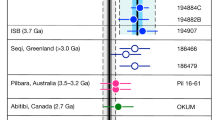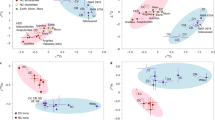Abstract
The excess of highly siderophile elements in the Earth’s mantle is thought to reflect the addition of primitive meteoritic material after core formation ceased1,2,3,4. This ‘late veneer’ either comprises material remaining in the terrestrial planet region after the main stages of the Earth’s accretion5,6, or derives from more distant asteroidal7 or cometary8 sources. Distinguishing between these disparate origins is important because a late veneer consisting of carbonaceous chondrite-like asteroids7 or comets8 could be the principal source of the Earth’s volatiles and water. Until now, however, a ‘genetic’ link between the late veneer and such volatile-rich materials has not been established or ruled out. Such genetic links can be determined using ruthenium (Ru) isotopes, because the Ru in the Earth’s mantle predominantly derives from the late veneer9, and because meteorites exhibit Ru isotope variations arising from the heterogeneous distribution of stellar-derived dust10,11. Although Ru isotopic data and the correlation of Ru and molybdenum (Mo) isotope anomalies in meteorites were previously used to argue that the late veneer derives from the same type of inner Solar System material as do Earth’s main building blocks6, the Ru isotopic composition of carbonaceous chondrites has not been determined sufficiently well to rule them out as a source of the late veneer. Here we show that all chondrites, including carbonaceous chondrites, have Ru isotopic compositions distinct from that of the Earth’s mantle. The Ru isotope anomalies increase from enstatite to ordinary to carbonaceous chondrites, demonstrating that material formed at greater heliocentric distance contains larger Ru isotope anomalies. Therefore, these data refute an outer Solar System origin for the late veneer and imply that the late veneer was not the primary source of volatiles and water on the Earth.
This is a preview of subscription content, access via your institution
Access options
Access Nature and 54 other Nature Portfolio journals
Get Nature+, our best-value online-access subscription
$29.99 / 30 days
cancel any time
Subscribe to this journal
Receive 51 print issues and online access
$199.00 per year
only $3.90 per issue
Buy this article
- Purchase on Springer Link
- Instant access to full article PDF
Prices may be subject to local taxes which are calculated during checkout


Similar content being viewed by others
References
Kimura, K., Lewis, R. S. & Anders, E. Distribution of gold and rhenium between nickel-iron and silicate melts—implications for abundance of siderophile elements on Earth and Moon. Geochim. Cosmochim. Acta 38, 683–701 (1974)
Chou, C. L. Fractionation of siderophile elements in the Earth’s upper mantle. Proc. Lunar Planet. Sci. Conf. IX, 219–230 (1978)
Brenan, J. M. & McDonough, W. F. Core formation and metal-silicate fractionation of osmium and iridium from gold. Nat. Geosci. 2, 798–801 (2009)
Walker, R. J. Highly siderophile elements in the Earth, Moon and Mars: update and implications for planetary accretion and differentiation. Chem Erde-Geochem. 69, 101–125 (2009)
Bottke, W. F., Walker, R. J., Day, J. M. D., Nesvorny, D. & Elkins-Tanton, L. Stochastic late accretion to Earth, the Moon, and Mars. Science 330, 1527–1530 (2010)
Dauphas, N., Davis, A. M., Marty, B. & Reisberg, L. The cosmic molybdenum-ruthenium isotope correlation. Earth Planet. Sci. Lett. 226, 465–475 (2004)
Wang, Z. & Becker, H. Ratios of S, Se and Te in the silicate Earth require a volatile-rich late veneer. Nature 499, 328–331 (2013)
Albarède, F. Volatile accretion history of the terrestrial planets and dynamic implications. Nature 461, 1227–1233 (2009)
Becker, H. et al. Highly siderophile element composition of the Earth’s primitive upper mantle: Constraints from new data on peridotite massifs and xenoliths. Geochim. Cosmochim. Acta 70, 4528–4550 (2006)
Chen, J. H., Papanastassiou, D. A. & Wasserburg, G. J. Ruthenium endemic isotope effects in chondrites and differentiated meteorites. Geochim. Cosmochim. Acta 74, 3851–3862 (2010)
Fischer-Gödde, M., Burkhardt, C., Kruijer, T. S. & Kleine, T. Ru isotope heterogeneity in the solar protoplanetary disk. Geochim. Cosmochim. Acta 168, 151–171 (2015)
Canup, R. M. Forming a Moon with an Earth-like Composition via a giant impact. Science 338, 1052–1055 (2012)
Cuk, M. & Stewart, S. T. Making the Moon from a fast-spinning Earth: a giant impact followed by resonant despinning. Science 338, 1047–1052 (2012)
Walker, R. J. et al. In search of late-stage planetary building blocks. Chem. Geol. 411, 125–142 (2015)
Morbidelli, A. et al. Source regions and timescales for the delivery of water to the Earth. Meteorit. Planet. Sci. 35, 1309–1320 (2000)
Ballhaus, C. et al. The U/Pb ratio of the Earth’s mantle: a signature of late volatile addition. Earth Planet. Sci. Lett. 362, 237–245 (2013)
Wood, B. J. & Halliday, A. N. The lead isotopic age of the Earth can be explained by core formation alone. Nature 465, 767–770 (2010)
Rubie, D. C. et al. Accretion and differentiation of the terrestrial planets with implications for the compositions of early-formed Solar System bodies and accretion of water. Icarus 248, 89–108 (2015)
Meisel, T., Walker, R. J. & Morgan, J. W. The osmium isotopic composition of the Earth’s primitive upper mantle. Nature 383, 517–520 (1996)
Fischer-Gödde, M. & Becker, H. Osmium isotope and highly siderophile element constraints on ages and nature of meteoritic components in ancient lunar impact rocks. Geochim. Cosmochim. Acta 77, 135–156 (2012)
König, S., Lorand, J.-P., Luguet, A. & Graham Pearson, D. A non-primitive origin of near-chondritic S–Se–Te ratios in mantle peridotites; implications for the Earth’s late accretionary history. Earth Planet. Sci. Lett. 385, 110–121 (2014)
Brandon, A. D., Humayun, M., Puchtel, I. S., Leya, I. & Zolensky, M. Osmium isotope evidence for an s-process carrier in primitive chondrites. Science 309, 1233–1236 (2005)
Yokoyama, T. et al. Osmium isotope evidence for uniform distribution of s- and r-process components in the early solar system. Earth Planet. Sci. Lett. 259, 567–580 (2007)
Hiroi, T., Zolensky, M. E. & Pieters, C. M. The Tagish Lake meteorite: a possible sample from a D-type asteroid. Science 293, 2234–2236 (2001)
Brandon, A. D., Humayun, M., Puchtel, I. S. & Zolensky, M. E. Re-Os isotopic systematics and platinum group element composition of the Tagish Lake carbonaceous chondrite. Geochim. Cosmochim. Acta 69, 1619–1631 (2005)
Rubie, D. C. et al. Highly siderophile elements were stripped from Earth’s mantle by iron sulfide segregation. Science 353, 1141–1144 (2016)
Dauphas, N. et al. Calcium-48 isotopic anomalies in bulk chondrites and achondrites: evidence for a uniform isotopic reservoir in the inner protoplanetary disk. Earth Planet. Sci. Lett. 407, 96–108 (2014)
Alexander, C. M. O. D. et al. The provenances of asteroids, and their contributions to the volatile inventories of the terrestrial planets. Science 337, 721–723 (2012)
Marty, B. The origins and concentrations of water, carbon, nitrogen and noble gases on Earth. Earth Planet. Sci. Lett. 313–314, 56–66 (2012)
O’Brien, D. P., Walsh, K. J., Morbidelli, A., Raymond, S. N. & Mandell, A. M. Water delivery and giant impacts in the ‘Grand Tack’ scenario. Icarus 239, 74–84 (2014)
Walsh, K. J., Morbidelli, A., Raymond, S. N., O’Brien, D. P. & Mandell, A. M. A low mass for Mars from Jupiter’s early gas-driven migration. Nature 475, 206–209 (2011)
Savina, M. R. et al. Extinct technetium in silicon carbide stardust grains: implications for stellar nucleosynthesis. Science 303, 649–652 (2004)
Bisterzo, S., Gallino, R., Straniero, O., Cristallo, S. & Käppeler, F. The s-process in low-metallicity stars—II. Interpretation of high-resolution spectroscopic observations with asymptotic giant branch models. Mon. Not. R. Astron. Soc. 418, 284–319 (2011)
Kruijer, T. S. et al. Neutron capture on Pt isotopes in iron meteorites and the Hf-W chronology of core formation in planetesimals. Earth Planet. Sci. Lett. 361, 162–172 (2013)
Acknowledgements
We thank the Meteorite Working Group at NASA, A. Bischoff and A. Greshake for providing the meteorite samples for this study, and K. Bermingham and B. O’Driscoll for providing the Shetland chromitite sample. We thank U. Heitmann, T. Kruijer and C. Proksche for their assistance, and A. Brandon, C. Brennecka and D. Papanastassiou for comments on the paper. This work was supported by the Deutsche Forschungsgemeinschaft (SFB-TRR 170, subproject B3-1). This is TRR 170 publication no. 11.
Author information
Authors and Affiliations
Contributions
M.F.-G. prepared the samples for Ru isotope analyses and conducted the measurements. Both M.F.-G. and T.K. were involved in the interpretation of the data and the writing of the manuscript.
Corresponding authors
Ethics declarations
Competing interests
The authors declare no competing financial interests.
Additional information
Reviewer Information Nature thanks A. Brandon and the other anonymous reviewer(s) for their contribution to the peer review of this work.
Extended data figures and tables
Extended Data Figure 1 Ruthenium isotope plots for chondrites and iron meteorites.
a, ϵ100Ru–ϵ96Ru; b, ϵ100Ru–ϵ102Ru. See the source data for Extended Data Fig. 1. Lines represent mixing lines between terrestrial Ru and an s-process component as defined by Ru isotope data for presolar SiC32 (dashed line), calculated s-process yields33 (dotted line) and corresponding calculated residuals for rapid neutron capture process (r-process) of stellar nucleosynthesis (dashed-dotted line). Uncertainties of individual data points reflect the external uncertainty of the method (2 s.d., for samples measured n < 4 times) or 95% confidence intervals (calculated as two-sided Student’s t-values, for samples measured n ≥ 4 times). Uncertainties for group averages of ordinary and enstatite chondrites are 95% confidence intervals, and uncertainties for non-magmatic IAB iron meteorites include propagated errors from secondary neutron-capture correction as given in Extended Data Table 2. Data for other iron meteorites are from ref. 11.
PowerPoint slides
Rights and permissions
About this article
Cite this article
Fischer-Gödde, M., Kleine, T. Ruthenium isotopic evidence for an inner Solar System origin of the late veneer. Nature 541, 525–527 (2017). https://doi.org/10.1038/nature21045
Received:
Accepted:
Published:
Issue Date:
DOI: https://doi.org/10.1038/nature21045
This article is cited by
-
Magma Ocean, Water, and the Early Atmosphere of Venus
Space Science Reviews (2023)
-
Enstatite chondrites: condensation and metamorphism under extremely reducing conditions and contributions to the Earth
Progress in Earth and Planetary Science (2022)
-
Nitrogen isotope evidence for Earth’s heterogeneous accretion of volatiles
Nature Communications (2022)
-
Late veneer and the origins of volatiles of Earth
Acta Geochimica (2022)
-
Nickel isotopic evidence for late-stage accretion of Mercury-like differentiated planetary embryos
Nature Communications (2021)
Comments
By submitting a comment you agree to abide by our Terms and Community Guidelines. If you find something abusive or that does not comply with our terms or guidelines please flag it as inappropriate.



